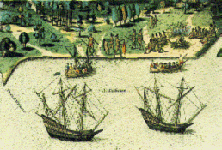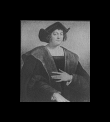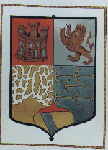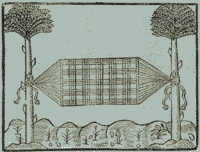Today in History: October 12
Columbus Day

Promontory of Florida
in the exhibition
1492: An Ongoing Voyage
A sailor on board the Pinta sighted land early in the morning of October 12, 1492, and a new era of European exploration and expansion began. The next day, the 90 crew members of Christopher Columbus's three-ship fleet ventured onto the Bahamian island of Guanahaní, ending a voyage begun nearly ten weeks earlier in Palos, Spain.

Christopher Columbus,
photograph of a painting,
copyright 1908.
Touring Turn-of-the-Century America, 1880-1920
As a reward for his valuable discovery, the Spanish crown granted Columbus the right to bear arms. His new Coat of Arms added the royal charges of Castile and Leon and an image of islands to his traditional family arms. Columbus further modified the design to include a continent beside the pictured islands.
Before his final voyage, the Spanish monarchs prepared a Book of Privileges, a collection of agreements showing how Columbus was remunerated for his explorations. In 1502, four copies of the book were known to exist. The Library of Congress's precious copy of this work is considered one of the "Top Treasures" included in the online exhibition American Treasures of the Library of Congress.

Columbus's Coat of Arms,
in the exhibition
1492: An Ongoing Voyage
The first recorded celebration of Columbus Day in the United States took place on October 12, 1792. Organized by The Society of St. Tammany, also known as the Columbian Order, it commemorated the 300th anniversary of Columbus's landing.
The 400th anniversary of the event, however, inspired the first official Columbus Day holiday in the United States. In 1892, President Benjamin Harrison issued a proclamation urging Americans to mark the day. The public responded enthusiastically, organizing school programs, plays, and community festivities across the country. Columbus and the Discovery of America, Imre Kiralfy's "grand dramatic, operatic, and ballet spectacle," is among the more elaborate tributes created for this commemoration. The World's Columbian Exposition, by far the most ambitious event planned for the celebration, opened in Chicago the summer of 1893.

Knights of Columbus,
1914.
Taking the Long View, 1851-1991
Over the following decades, the Knights of Columbus, an international Roman Catholic fraternal benefit society, lobbied state legislatures to declare October 12 a legal holiday. Colorado was the first state to do so on April 1, 1907. New York declared Columbus Day a holiday in 1909 and on October 12, 1909, New York Governor Charles Evans Hughes led a parade that included the crews of two Italian ships, several Italian-American societies, and legions of the Knights of Columbus. Since 1971 Columbus Day, designated as the second Monday in October, has been celebrated as a federal holiday. In many locations across the country Americans parade in commemoration of the day.

Hammock,
Oviedo, 1535
1492: An Ongoing Voyage
Oviedo came to America in 1514 and for over thirty years compiled detailed ethnographic descriptions of the goods, products, peoples and customs of the Caribbean and Central America.
Today, many Americans celebrate Columbus Day as a day of rest and relaxation. Appropriately, both hammocks and chocolate were introduced to Europeans by the people of the New World. Search across American Memory on the terms chocolate or hammock to find samples of their use during the nineteenth and twentieth centuries.
Learn more about Columbus and his legacy:
- Search the American Memory pictorial collections on Columbus to view additional monuments to Columbus. See, for example, one of the largest monuments to the explorer, the Columbus Monument at Columbus Circle in New York City.
- Explore the following collections which testify to the importance of Spain and the Spanish language in the exploration and European settlement of North America and the Carribbean:
- Learn more about the explorer's historical legacy by visiting the exhibition 1492: An Ongoing Voyage.
- Read interviews with Italian-Americans. Search the collection American Life Histories, 1936-1940 on Italian.
- Examine an award-winning quilt commemorating the Quincentennial of Christopher Columbus's arrival in the New World (1492-1992). This quilt is featured in the collection Quilts and Quiltmaking in America: 1978-1996.